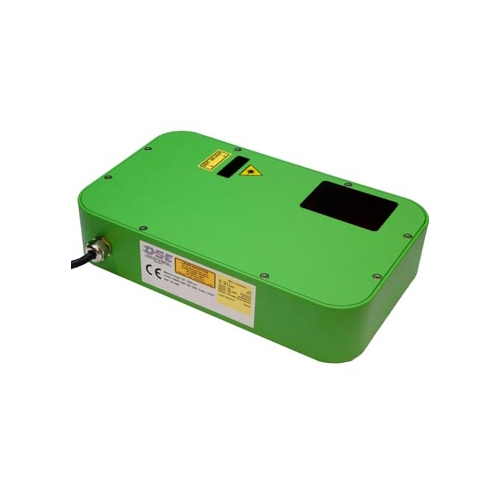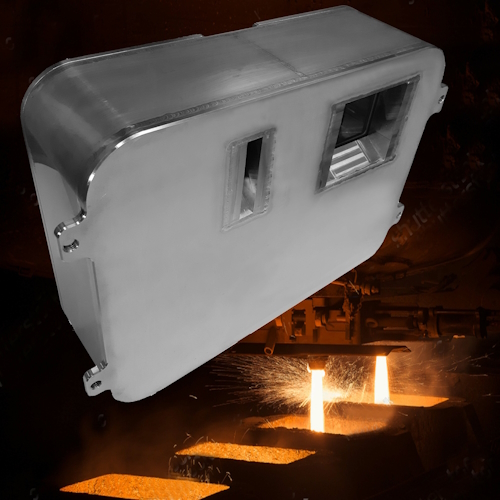|
MODULOC SENSOR ENTERPRISES offers
the
2D
Laser Profile Scanners
from
Danish Sensor Engineering (DSE).
The DSE O2DS Z-Line
Laser Profile Scanners is a series of laser
scanners that specialize in performing profile
measurement in 2D. The measurement is achieved by
oscillating the triangulation plane over an angle, with
a maximum specified angle of 50°. These scanners utilize
a fine collimated or focused laser beam that diffusely
reflects from the surface of various objects. Through
the use of a CCD camera and a Digital Signal Processor,
the scanners accurately determine the radial distance
from the mirror axis to the target surface and maintain
the angular reference position.
The DSE O2DS Z-Line covers 8
different radial measuring ranges. The smallest is 100 mm and
largest is 2400 mm. The resolution varies from 0.03 mm
to 0.8 mm. The smaller the measuring range is, the
better the resolution will be. O2DS Z models are
available with measuring frequencies of 2 kHz or 6 kHz.
The DSE O2DS Z-Line is a compact
unit with integrated optics, CCD camera, and digital
electronics all are integrated in the sensor housing. There is no need for a separate controller
unit. The output is a serial interface RS-422 or RS-232
(or optional Ethernet).
The DSE O2DS Z-Line
Laser Profile Scanners is delivered with CDs
containing application software which is a DLL library for programs
running under Windows. The PC application program
receives output data from the scanner over the
RS422/RS232 serial interface (or Ethernet ) and a COM
port via the DLL. The software either converts polar
coordinates of a measurement point to orthogonal X,
Y-coordinates or presents a profile (table of X, Y
values) for each sweep from one side to the other.
Within the application program the user can specify the
seize of the Y-increment and thus the length of the
output table containing the profile data.
Synchronization: As a
rather unique feature the DSE O2DS Z-Line
Scanner is available in synchronized versions
where two or more units works together to perform
complex 2D/geometric measurements. The working principle
is one master scanner unit together with one or more
slave units as for example, when four units controls
dimensions and shape in tube- or similar productions
process.
High Temperature Target: To meet this demand, the
DSE O2DS Z-Line Scanner can be modified
into High Temperature versions to reach different levels
of surface temperature. The Versions are named the HT,
VHT and VVHT The HT version is made for
surface temperatures up to 1000°C (1832°F). The VHT can
handle surface temperatures up to 1300°C (2372°F). The
VVHT, using a BLUE laser diode is capable of measuring
on extreme hot target surfaces up to 2200°C (3920°F).
Protective Housing: A water cooled protection housing is available as an
optional accessory. To further expand the usability of
DSE O2DS Z-Line scanners for High
Temperature applications, DSE has developed a
water-cooled protection housing in stainless steel to
totally enclose the sensors.
The sensor is
surrounded on all sides except from the backside by 5
water chambers. This ensures a very effective cooling
and protection and allow the sensor to operate close the
hot targets such as white glowing steel. |
|
|
| |
 |
 |
|
DSE O2DS Z-Line Laser
Profile Scanners
|
DSE O2DS Z-Line Water Cooled
Housing
|
Radial
Distance Range: 200-2400 mm.
Scan
Arc: 10° or 50°
Scan Rate: 2 kHz
or 6 kHz
8 Models Available
3
HighTemperature Versions Available |
for
High Temperature applications
Stainless Steel Construction
Scanner is surrounded by 5 water
cooled chambers on all sides
except for the backside.
Can also
be air cooled using Vortex Air
Cooler
|
|
|
|
Examples of where the DSE
O2DS Z-Line Laser Profile Scanners are being
used:
Food Industry:
Measuring volume of cheese before it is cut out
in segment and equal weight.
Metal
Industry: Measuring side profiles of aluminum
slabs.
Steel Industry: Measuring height
of slabs instead of thickness from above and
below. Measuring side profiles of slabs.
Measuring diameter of tubes.
Car
Industry: Profile measuring tire sides. |
| |
|
|
|
|
|
|
|
|



